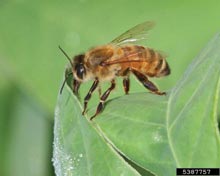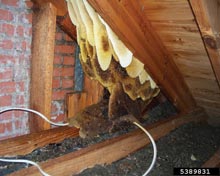
Johnny N. Dell

Timothy Haley, USDA Forest Service
Honey Bee
General Description
The honey bee is a half-inch long, hairy, honey-brown insect. They should not be confused with yellow jackets,
which are black and bright yellow wasps. Honey bees live in extra large colonies of up to 50,000 individuals. Their
colonies can grow this large because they survive winter, even in northern states. The nest consists of several
tiers or “combs” made of beeswax. It is located in cavities of trees, rock formations and buildings. In spring, a
colony may produce a “swarm.” This occurs when a newly produced queen flies off with about half the colony’s
worker bees to establish a new colony. These swarms often come to rest on trees and houses while scout bees
search for a good spot for a new nest. If possible, such swarms should be tolerated, as they are in transit and
usually leave within two to four days.
General Control
Honey bees are beneficial pollinators and should be left alone unless their nests are in conflict with human
activity. If honey bees nest in the walls of a home, they can be removed or killed if necessary; however, it is
advisable to open the area and remove the honey and combs because rodents, insects and fungi will be
attracted to the nest. After removal, the cavity should be filled to prevent future swarms from creating a nest.
You may want to seek the assistance of a professional beekeeper or exterminator. You can prevent swarms from
nesting in walls by preventive maintenance. Honey bees look for an existing entrance, so periodic inspection and
caulking is all that is necessary to prevent them from occupying spaces in walls.









